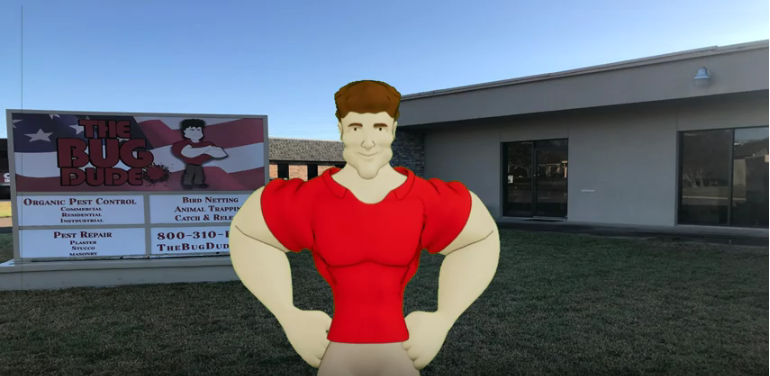You saw it, but you can’t believe it—a termite crawling across the top of your desk. Immediately, the frantic internal questioning begins. Was that the only termite or the first of many? Are there termites in the area? Or, worst of all, are there termites living in my house? If you are suspicious that you may have a termite problem, don’t ignore it! The sooner you find the truth, the sooner you can take action to protect your hard-earned home. Obviously, the best step to take would be to call a company offering pest control in Fort Worth. However, there are a few things you can do to determine whether you may need termite pest control in Fort Worth.
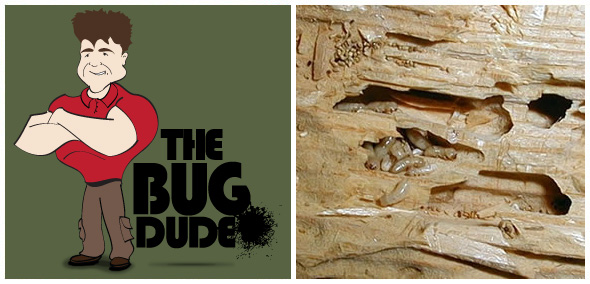
The first tip may seem a little obvious: look for termites. Poke around your home to see if you can find the ant-looking creatures. You’ll especially want to check damp places near wood surfaces. Termites are often very small, usually no bigger than a grain of rice, so be sure to check carefully. Also, if you notice that a swarm of little ant-like insects seem to appear after a rainfall, then you need to call for pest control in Fort Worth immediately. Termites can do a lot of damage in a relatively short period of time; so, the earlier you can find them, the more effective termite pest control in Fort Worth can be.
Another tell-tale sign to search for is the appearance of mud holes. Mud holes look like tiny tunnels (roughly equivalent to a pencil in diameter) that lead directly into the center of the wood. The termites use these tunnels to access new wood sources and continue expansion. If you happen upon some of these tunnels, check to see if any of them are filled-in with mud. If it is, you need pest control in Fort Worth as soon as possible. The mud walls are a sign that the termites are preserving their old tunnels to move on to new ones.
Wood decay is a tantamount indication that you need termite pest control in Fort Worth. The end result of many hours of termite infestation is ruined wood and usually rotting. If, during your investigation, you find rotting wood, you’ll want to solicit the opinion of an expert.
Dealing with termites is never an enjoyable experience. However, keeping an eye out for these signs will help you determine whether you need termite pest control in Fort Worth or just a little bug spray. If you even suspect that termites may be living in your house, it’s always best to call-in a professional in pest control in Fort Worth. Remember, the earlier the detection, the sooner you can stop the destruction of your home.
Pest Control Arlington TX
Wednesday, October 17, 2012 | Mid-Cities Pest Control
Finding the Best Pest Control in Arlington, Texas
Many people can recall that terrifying moment when they discovered ants in the cabinets, beetles in their bedroom, or termites in the woodwork. Discovering an insect problem can be an awful experience, but dealing with it doesn’t have to be. There are many companies that, for a small fee, offer pest control in Arlington, Texas and will help you with your problem. However, with so many companies soliciting pest control in Arlington, Texas, how can you know which ones are the professionals and which ones are simply going to spray your baseboards? Here are some helpful hints to finding professional pest control in Arlington, Texas.
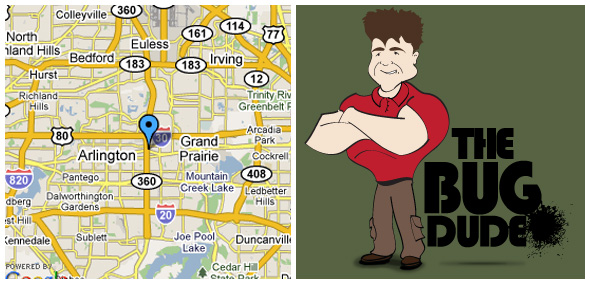
- Search for awards. Though it may seem like an unnecessary piece of paper, awards for excellence in business go a long way in establishing a company’s credibility. Being recognized by a third party as having exemplary customer service is an honor for a business to receive. However, more importantly, awards show a distinction from subpar businesses and inexperienced startups. When a company offering pest control in Arlington, Texas, has no awards, it likely means the company is inexperienced or incapable.
- Listen for recommendations. Satisfied customers are one of the greatest endorsements a company can have. The next time you hear someone talking about pest control in Arlington, Texas, ask them about the company that they used. Were they on time, courteous, and effective? The information that they give you can often be a very valuable guide to selecting a company.
- Investigate their reputation. In an age of unprecedented connectivity, customer reviews are generally not hard to find. Often, a quick query on a search engine or a customer review site like Angie’s List will reveal a host of valuable information. Remember: a good company will have satisfied customers. When looking for pest control in Arlington, Texas, expect to see some good reviews.
- Go local. It may be tempting to choose a large national exterminating company for your needs, assuming that size equals quality. However, many times, choosing a company that specializes in your region’s pests and insects is a far better choice. Local companies have likely dealt with the exact problems you are dealing with and have experience handling them. So, when choosing pest control in Arlington, Texas, don’t just go for size. Go for results.
Going through a pest problem is generally never enjoyable. However, if you choose the right pest control, it doesn’t have to be difficult. Just do a little research and ask around; you may be surprised at what kind of deals you can get.
Fire Ants
Wednesday, August 08, 2012 | Mid-Cities Pest Control
The Dreaded Fire Ants
There is nothing that will ruin a backyard cookout with family, and friends than the arrival of fire ants. These pests are quite common in the state of Texas, and posses a painful bite. The Bug Dude at Mid-Cities Pest Control is equipped to deal with your fire ant problems.
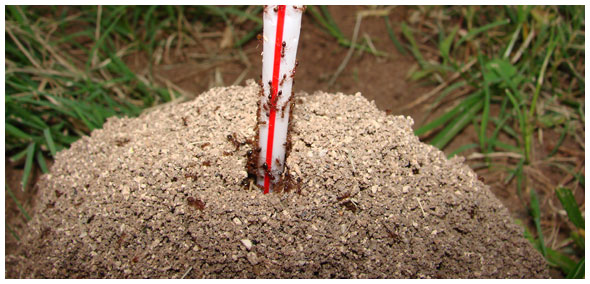
What Are Fire Ants?
What are fire ants, and where did they come from? According to Texas A & M University,
“In the 1920s, the red imported fire ant arrived in Alabama from South America. Since then the invader has infested over 56 million acres in Texas.” 1
These unpleasant invaders have been the scourge of backyards ever since. With their painful bites and stings; and seemingly endless numbers, fire ants are certainly unwelcome in your backyard.
Unfortunately these fire ants are extremely aggressive, and they already infest much of the state of Texas. Fire ants are also continuing to spread to additional regions, and states. While there is no way to completely eliminate fire ants from your yard, their presence can be significantly reduced.
How To Identify Fire Ants?
The easiest way to identify the stinging exotic fire ants from native ants is to have a professional inspect them. These invaders can look almost identical to native ants, but can pose a much bigger problem. Native ants such as the leafcutter ant, and the harvester ant do not pose the risk of painful ant bites.
How Can Fire Ants Be Controlled?
While the complete elimiation of the fire ant from the state of Texas is not plausible at this time, however they can be greatly reduced, or temporaily eliminated from smaller areas.
Proper application of ant bait is the most effective way of controlling fire ants. Our pest control experts will apply the baits in a manner that will be greatest reduction of fire ants, and with regular treatments re-infestation can be minimized.
Get Fire Ant Treatment Today!
Don’t let fire ants ruin your outdoor activities! Call The Bug Dude at Mid Cities Pest Control to take back your yard.
Wasp Control
Friday, June 08, 2012 | Mid-Cities Pest Control
Are you in need of Wasp Control
Wasps come in many types and sizes. The ones that are of most concern to people because of their stinging habits are yellow jackets and hornets. Some social wasps are predators for most or all of the year and provide a great benefit by killing large numbers of plant-feeding insects and nuisance flies; others are exclusively scavengers. Wasps will also forage on foods that people eat, especially sweets and meats.
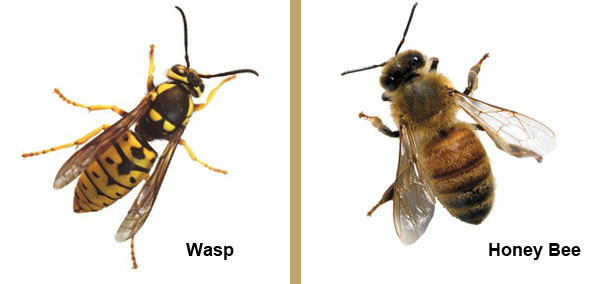
Due to their size and coloration these wasps are often mistaken for bees. Bees are not nearly as aggressive and are valued as major pollinators as well as honey producers.
All wasps will defend their nests, but the Yellow Jackets and hornets are the most aggressive. They can be distinguished from bees by their thin “waists.” Bees are thick-waisted. They fold their wings lengthwise when at rest. The wasp colony will remain active for only one summer, after which the queens will fly away to start more colonies. The remaining ones, die at the end of the summer, the nest is not reused.
Wasps become a problem only when they threaten to sting humans. One of the most troublesome of the social wasps is the yellowjacket. Yellowjackets, especially ground- and cavity-nesting ones such as the western yellowjacket, tend to defend their nests vigorously when disturbed. Defensive behavior increases as the season progresses and colony populations become larger while food becomes scarcer. In fall, foraging yellowjackets are primarily scavengers and they start to show up at picnics, barbecues, around garbage cans, at dishes of dog or cat food placed outside, and where ripe or overripe fruit are accessible. At certain times and places, the number of scavenger wasps can be quite large.
The need for wasp control is based on their persistent, pugnacious behavior around food sources and their aggressive colony defense. Stinging behavior is usually encountered at nesting sites, but scavenging wasps sometimes will sting if someone tries to swat them away from a potential food source. When scavenging at picnics or other outdoor meals, wasps will crawl into soda cans and cause stings on the lips, or inside the mouth or throat.
Do you need wasp control?
Most social wasps provide an extremely beneficial service by eliminating large numbers of other pest insects through predation and should be protected and encouraged to nest in areas of little human or animal activity. Although many animals prey on social wasps (including birds, reptiles, amphibians, skunks, bears, raccoons, spiders, preying mantids, and bald-faced hornets), none provides satisfactory wasp control in home situations.
The best way to prevent unpleasant encounters with social wasps is to avoid them. If you know where they are, try not to go near their nesting places. Wasps can become very defensive when their nest is disturbed. Be on the lookout for nests when outdoors. Wasps that are flying directly in and out of a single location are probably flying to and from their nest.
Scavenging wasps will not usually become a problem if there is no food around to attract them. When nuisance wasps are present in the outdoor environment, keep foods (including pet food) and drinks covered or inside the house and keep garbage in tightly sealed garbage cans. Once food is discovered by wasps, they will continue to hunt around that location long after the source has been removed.
If wasp nests must be eliminated, it is easiest and safest to call for professional help.
If wasp control is needed, seek the assistance of a professional pest control operator who can use many different methods to control these pests including: trapping wasps in a baited trap designed for that purpose, early-season removal of nests, or spraying the nest or nesting site with an insecticide labeled for that use.
Wasp Control Source Article
Commonly Asked Questions About Termite Control
Monday, May 14, 2012 | Mid-Cities Pest Control
TERMITE CONTROL: Answers for Homeowners
What Do You Need to Know About Termite Control
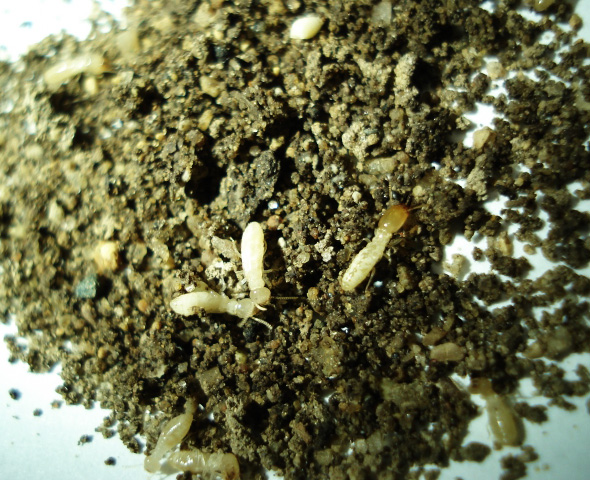
Subterranean termites are serious pests, and termite control is best left to professionals. Termites and termite control services can be confusing, however, and there are more options available today than ever before. Some of the most common termite questions raised by homeowners are answered below.
- Why worry about termite control?
- Why are infestations often discovered during March – May?
- How will I know if my home is infested?
- Can I treat the house myself?
- Which treatment methods and products are most effective?
- Does the entire house need to be treated — or can they just treat areas where I see termites?
- How long will the treatment last?
- Will the chemicals harm my family or pets?
- Have I been “cheated” if termites continue to infest my house after treatment?
Q: Why worry about termite control?
A: Termites cause billions of dollars in damage each year. They primarily feed on wood, but also damage paper, books, insulation, and even swimming pool liners and filtration systems. Termites can injure living trees and shrubs, but more often are a secondary invader of woody plants already in decline. While buildings may become infested at any time, termites are of particular importance when buying or selling a home since a termite inspection/infestation report is normally a condition of sale. Besides the monetary impact, thousands of winged termites emerging inside one’s home are an emotionally trying experience — not to mention the thought of termites silently feasting on one’s largest investment.
Q: Why are infestations often discovered during March – May?
A: Spring typically is when large numbers of winged termites, known as “swarmers,” emerge inside homes. In nature, termites swarm to disperse and start new colonies. Triggered by warmer temperatures and rainfall, the winged termites emerge from the colony and fly into the air. Above: Winged termites emerging indoors are a sure sign that the building is infested.
The swarmers then drop to the ground, shed their wings, pair off with a mate, and attempt to begin new colonies in the soil. Few swarmers emerging outdoors survive to start new colonies. Swarmers emerging indoors are incapable of eating wood, seldom survive, and are best removed with a vacuum. They do, however, indicate that an infestation is present.
Q: How will I know if my home is infested?
A: Discovering winged termites indoors almost always indicates an infestation warranting treatment.
People often confuse winged termites with ants, which often swarm at the same time of year. Termites can be differentiated by their straight antennae, uniform waist and wings of equal size. (Ants have elbowed antennae, constricted waists and forewings that are longer than the hind wings.)
The swarmers are attracted to light and are often seen around windows and doors. Termite swarmers emerging from tree stumps, woodpiles, and other locations out in the yard are not necessarily cause for concern, and do not necessarily mean that the house is infested. On the other hand, if winged termites are seen emerging from the base of a foundation wall or adjoining porches and patios, there’s a good chance the house is infested also and treatment may be warranted.
Other signs of infestation are earthen (mud) tubes extending over foundation walls, support piers, sill plates, floor joists, etc. The mud tubes are typically about the diameter of a pencil, but sometimes can be thicker.
Termites construct these tubes for shelter as they travel between their underground colonies and the structure. To help determine if an infestation is active, the tubes may be broken open and checked for the presence of small, creamy-white worker termites.
If a tube happens to be vacant, it does not necessarily mean that the infestation is inactive; termites often abandon sections of tube while foraging elsewhere in the structure.
Termite-damaged wood is usually hollowed out along the grain, with bits of dried mud or soil lining the feeding galleries. Wood damaged by moisture or other types of insects (e.g., carpenter ants) will not have this appearance. Occasionally termites bore tiny holes through plaster or drywall, accompanied by bits of soil around the margin. Rippled or sunken traces behind wall coverings can also be indicative of termites tunneling underneath.
Oftentimes there will be no visible indication that the home is infested. Termites are cryptic creatures and infestations can go undetected for years, hidden behind walls, floor coverings, insulation, and other obstructions. Termite feeding and damage can even progress undetected in wood that is exposed because the outer surface is usually left intact.
Termite control often requires the keen eye of an experienced termite inspector. However, even the most experienced inspector can overlook infestation or damage which is hidden.
Q: Can I treat the house myself?
A: Ridding a home of termites requires special skills. A knowledge of building construction is needed to identify the critical areas where termites are likely to enter. Many of these potential points of entry are hidden and difficult to access. Termite control also utilizes specialized equipment such as masonry drills, pumps, large-capacity tanks, and soil treatment rods. A typical treatment may involve hundreds of gallons of a liquid pesticide, known as a termiticide, injected into the ground alongside the foundation, beneath concrete slabs, and within foundation walls.
In short, termite control is a job for professionals. A possible exception would be if a mailbox post, sandbox or other small wooden object not attached to the house was infested. “Do-it-yourself” products, sold to homeowners at retail stores or bought over the internet, will seldom eradicate an existing termite problem.
Q: Which treatment methods and products are most effective?
A: Another challenging question. There are two general categories of termite treatment, liquids and baits. Soil-applied liquid termiticides have been around for decades. Their purpose is to provide a long-lasting chemical barrier that excludes termites in the ground from entering buildings. In most cases, termites in the structure die off as well, since they cannot return to the soil. Most former products were repellent rather than lethal to termites foraging in the soil. Newer materials, are non-repellent and termites tunneling into the treatment zone are killed. Overall the non-repellent products are proving to be more reliable in their ability to resolve termite problems in the first attempt. All registered termiticides (both repellent and non-repellent) can be effective, however, and homeowners should not base their purchasing decision on product alone.
The other broad treatment category is baiting. Termite baits consist of paper, cardboard, or other palatable food, combined with a slow-acting substance lethal to termites. The baits are installed below ground out in the yard in cylindrical plastic stations. Others are sometimes placed indoors over active mud tubes. Foraging termites consume the bait and share it with their nestmates, resulting in a gradual decline in termite numbers. On some properties, baits may constitute the only form of treatment; on others, they may be combined with liquid applications. to areas where termites are observed.
Termite baiting is a very complex subject. Regardless of which method or product is selected, it’s important to have an experienced technician, backed by a responsible pest control firm.
Q: Does the entire house need to be treated… or can they just treat areas where I see termites?
A: Subterranean termite colonies may contain hundreds of thousands of individuals, foraging in many different directions. For the homeowner, localized or “spot” treatments are generally a gamble except in cases of retreatment. Most reputable pest control firms will not warranty spot treatments, since it’s likely that termites will eventually find other points of entry into the structure.
Some companies may offer to do a so-called “perimeter” treatment, using one of the non-repellent liquid termiticides. Typically this will involve a thorough application around the entire outside foundation wall of the building, and spot-treating any infested or high-risk interior areas. If the homeowner is considering such a treatment, they should inquire whether it will be accompanied by a service agreement in case termites return. (Service renewal agreements usually state that if termites return, the company will return and retreat the affected areas at no additional charge provided the renewal agreement is maintained.) It’s a bit of a gamble to purchase any termite treatment option without an ongoing service agreement.
Q: How long will the treatment last?
A: All liquid termiticides are supposed to control termites for at least five years when applied according to label directions. The actual length of control on a given structure will depend on such factors as thoroughness of the application, environmental conditions, and density of termites in the area. If termites swarm again and continue to be a problem the year after treatment, it’s usually not from degradation of the termiticide – but because termites have found an untreated gap in the chemical barrier.
Q: Will the chemicals harm my family or pets?
A: Termiticides are tested extensively for adverse effects on health. Before a product can be used, numerous studies are conducted by the manufacturer and independently evaluated by the U.S. Environmental Protection Agency. Based on the current body of knowledge, registered termiticides pose no significant hazard to humans, pets or the environment when applied according to label directions. Despite the negligible health risk from a properly performed termite treatment, people with lingering concerns should consult their physician. Most of the newer liquid products have essentially no odor. Clients who are still apprehensive may want to consider having their home treated with baits.
Q: Have I been “cheated” if termites continue to infest my house after treatment?
A: Not necessarily. Unlike other services such as plumbing or electrical work, termite control involves living creatures. The best treatments performed by knowledgeable firms may fail at times, when termites find their way through tiny, untreated gaps in the soil. While the intent is to establish a continuous, impenetrable chemical barrier, this is all but impossible to achieve in actual practice. In the case of baits, it may take several months for termites to initially find the below-ground installations and several months more to achieve control.
The key is to hire a reputable pest control firm employing experienced, conscientious technicians. Companies will return and retreat affected area(s) at no additional charge provided the service agreement is purchased and maintained.
Termite Control Source Article
Q & A: Skunks
Thursday, March 29, 2012 | Mid-Cities Pest Control
No one likes a skunk. They are smelly, they are are aggressive, and the are destructive. Here is a quick Q & A about skunks, so that you can be informed about potential hazards these pests pose.
Be sure to contact The Bug Dude for all your needs regarding skunks.
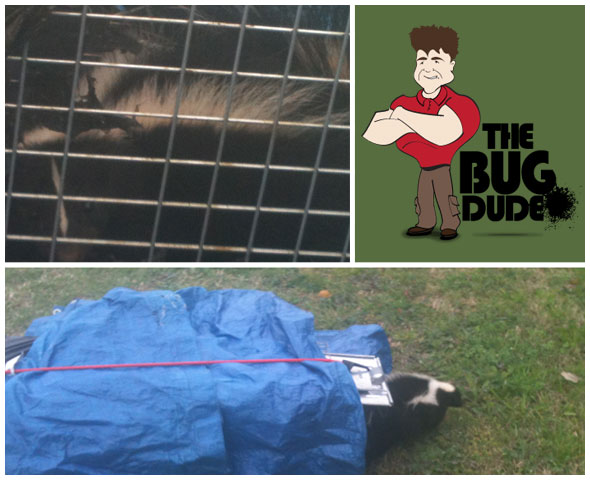
Q-1. WHERE DO SKUNKS LIVE?
A. Skunks, or mephitidae, are found in both North and South America, excluding only the farthest northern reaches of Canada. Four skunk species can be found in North America, though the striped skunk is the most common. Spotted skunks mostly live in northern Mexico. Hooded skunks stay in the southwestern United States.
In the wild, skunks prefer to live in open lands next to forest areas and in clearings and pastures. On a prairie, skunks will make their homes in timber alongside a river or in thickets. Hollow logs can also become skunk homes.
Skunk dens are lined with hay, grass or leaves. Skunks will usually have more than one den, and they will go from one to the other to loaf throughout the day.
But often, skunks move into human territory. Skunks will burrow under sheds, homes, businesses, porches, decks, crawlspaces and woodpiles and create a home. They will enter foundation openings to get to these spots or create a skunk hole themselves. They have large feet with well-developed claws which make them very good diggers. In urban areas, skunks can also be found in industrial parks with large open areas.
Skunks are very sensitive to light, which is why they prefer the cool darkness of their dens during the day.
Q-2. WHEN ARE SKUNKS MOST ACTIVE?
A. Skunks are nocturnal, so you will rarely see them during the day near your home or business.
They start the mating process in February. About 10 weeks later, 2 to 8 babies, and sometimes up to 16 babies, will be born. Female skunks only have one litter per year. Skunk pups are wrinkly, blind and almost hairless. Skunk babies will be independent by the following spring.
Though most wild skunks only live for about three years, some have been known to live up to 10.
Compared to some other small mammals, male skunks will travel pretty far. Though most will stay in the bounds of ½ to 2 miles from home, a male skunk may travel up to 5 miles during mating season. Female skunks are not great travelers.
During mating season, male skunks are often hit by cars. Their behavior during this time causes them to be active during the day, move very slowly and not leave an area, even if they are in danger.
In the coldest parts of winter skunks will lay dormant for about a month. At this time of year, they might create a hotel and den together for warmth, but otherwise they aren’t normally very social animals.
Q-3. WHAT FOODS DO SKUNKS EAT?
A. Skunks eat both plant and animal foods. Spring and summer are the times of year when they eat the most animal matter, since that is when insects are more available. Crickets, grasshoppers and beetles are their favorite insects. In the winter, mice serve as a huge portion of the skunk diet. When it is very hungry, a skunk may eat rats, rabbits and other small mammals.
Skunks also like to feed on garbage if they are living near humans. Dumpsters provide an easy and plentiful source of skunk food.
Q-4. WHY SHOULD I GET RID OF SKUNKS UNDER MY HOUSE OR BUSINESS?
A. If the lower ears of your corn stalks have been eaten away, a skunk is the likely culprit. If you hear a noise under your porch or building, a skunk may be setting up its home. If your lawn, garden or golf course is covered with cone-shaped holes and patches of dirt, a skunk may be searching for insect grubs.
All in all, skunks under your house or building can do a lot of expensive damage to your landscape, not to mention the odor they can produce in and around your home, or on you, your children, or house pets. Skunk spray will contaminate carpets, drapes, furniture and clothing.
A skunk is so brightly colored as if to say, “Watch out!” This is because skunks have the ability to discharge a nauseating musk from their anal glands and are capable of emitting several of these discharges one after the other. Skunks can spray their pungent smell from up to 15 feet away, or if it’s a windy day, even farther. If you are the lucky one who gets sprayed by a skunk, you will be blinded for about 15 minutes and your eyes will sting. Nosey house pets are not immune to the skunk’s spray. Obviously, the smell is there to ward off predators that get a whiff and don’t want any more. Skunk spray has evolved to smell similar to what other animals recognize as decay, which they’ll naturally shy away from. Skunk juices actually glows at night.
Before a skunk releases its scent, it will usually stamp its front feet and growl or hiss. Once a skunk lifts its tail, it usually means its victim will be covered with oily, thick skunk juice.
When skunks dig in your yard for food, a practice called “grubbing,” skunks can tear up your lawn to the point where it is beyond repair. Skunks will do grass damage to yards, golf courses, parks and other landscaping
If a skunk should choose to die under your home or business, the skunk odor will emanate into the living quarters, causing headaches and nausea. Skunk odor will contaminate carpets, fabrics, couches and clothing. Skunk smell will saturate fabrics and furniture, and can destroy insulation and any other item it comes into contact with if left alone long enough. Skunk odor can stick around for up to three years after it is sprayed.
While digging under your home or business, skunks will often fall into an area under the foundation and not be able to get themselves out because they are not good climbers. Trapped, the skunks end up dying, leaving a rotting skunk smell in their wake.
Skunks will tear into areas of your home or business and haunt it for years to come. Sometimes, so many shack up that the space becomes a skunk hotel. All this skunk damage will affect the value of your property. It is difficult to sell a home that has a skunk infestation and actually, it’s required by law that you fix a skunk problem before you sell your home. Property value can decrease between five percent and ten percent due to a skunk infestation.
Q-5. I HEARD SKUNKS CARRY DISEASES. IS THAT TRUE?
A. Yes, skunks are one of the primary carriers of rabies. Rabies, a virus, progressively paralyzes and can kill any mammal, including humans. Rabies is generally contracted through contact with an infected skunk through biting. Though humans should avoid contact with any skunks, if a skunk seems especially fearless around humans or is very active during the day, it could be infected.
Another illness spread by skunks is canine distemper. Distemper is a disease in dogs that is contagious, incurable and can be fatal. Domesticated dogs catch the virus when they come into contact with the bodily secretions of a sick skunk.
Skunks are also heavily infested with pests, which can spread into your home or business searching for hosts. Ticks, fleas and mites are all known carriers of disease.
Several cases of mites biting humans indoors have been reported.
Ticks are very mobile and have been known to crawl into buildings that skunks are living under, and may travel great distances to attach themselves to people.
If a skunk brings fleas into your home, most likely the biting bug will hop onto your house pet’s back. Once inside, large flea populations can build up quickly. Fleas live on the outside of their hosts’ bodies and need to feed on blood in order to produce eggs.
A skunk bug living near your home can become an infestation in your pantry or carpet in no time. One or two mites may stray from the skunk den and crawl along your kitchen table. But if the skunk abandons its den for any reason, the whole caboodle of skunk bugs will enter your home, looking for a new host. This is why it’s especially important to have our skunk control experts remove skunk garbage after all the skunks have been trapped.
Skunks are a liability for businesses and restaurants. Skunk diseases or skunk bugs may infect your employees, guests or food. There are documented cases of illnesses occurring in these situations, and the plaintiff successfully sues the owner of the business. Also, if you are an employer and your workers’ environment is being contaminated by skunks, you will see a drop in productivity due to illness.
Source Article
Why Use a Professional Pest Control Company
Friday, February 03, 2012 | Mid-Cities Pest Control
Professional Pest Control
Hiring a professional pest control service provider or exterminator offers several advantages over attempting to control and exterminate pests such as rodents, cockroaches, spiders, termites and ants in and around your property on your own. Professionally trained pest control service providers can resolve and prevent infestation, and also intervene on an emergency basis.
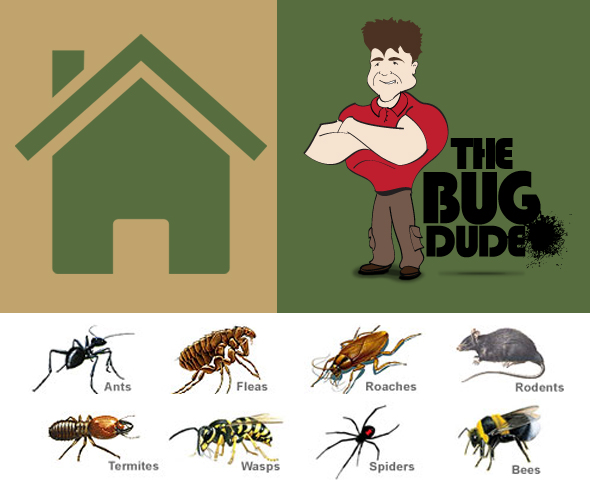
Function
Professional pest control service providers perform extermination procedures using highly potent chemicals to eradicate certain types of pests. They can set up termite and pest-baiting systems, and also protect the home or property from infestation by administering treatments on a weekly, monthly or quarterly basis. Unlike do-it-yourself pest control kits, professional pest control services can treat and prevent infestations over the long term.
Types of Pest Control Services
When working with a professional pest control service provider, you may be able to choose from the following types of services: pre-treatments for new construction, perimeter treatment to exterminate pests before they enter the home, emergency services to remove hives and kill pests that may be populating a certain area of the home, termite monitoring systems, infestation inspections, sanitization services, and sealing and caulking of certain structures to eliminate avenues of entry.
The Pest Control Process
When working with a pest control service provider, the first step is to undergo a thorough inspection. The provider will be able to document each area of the property that has been or is at risk of being infested, and will also take a close look at the types of pests affecting the area. The professional may also ask you what types of pests you have seen or encountered. After the inspection report is complete, the service provider can provide you with a proposal of services that may include pre-treatments, extermination treatments, sanitization and follow-up treatments.
Key Benefits of Pest Control
The key benefits of working with a pest control professional instead of attempting to eliminate pests on your own include thorough evaluation and inspection of your home that may detect areas that you did not know about, use of chemicals and compounds that do not damage the interior and exterior of the home, and the ability to close off all avenues of entry with general repair services.
Considerations
Pricing for professional pest control services can vary from region to region. Your quote will depend on the size of the home, the size of the lawn, whether you need interior and exterior treatments, the number of treatments you need over the recommended treatment plan, and the number of hours it will take to perform your required services. You can request for a site inspection with a breakdown of all services and rates so you know exactly what to expect from the service provider.
Be sure to contact The Bug Dude for all your pest control needs.
Phone: Toll Free: 800-310-BUGS (2847)
Phone: Local: 817-354-5350
Fax:817-540-0569
Pest Control Source Article
Winter Pests
Monday, January 09, 2012 | Mid-Cities Pest Control
Dealing With Winter Pests
Don’t Let Pests Take Refuge In Your Home
Winter weather is a time where pests want to hide in the warmth of your home. Most folks think of rats and mice, but many other pests like ants are also prone to hiding indoors in the wintertime.
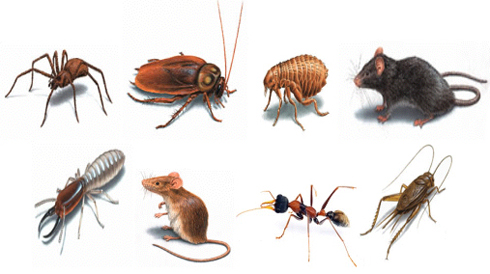
Rats, mice, and squirrels love to nest in attics during the winter. They burrow through the insulation and huddle around furnaces. They can be especially annoying by scratching in the ceiling and walls, keeping you up all night. They can also turn your attic into a disaster zone by contaminating the insulation with feces and urine.
It is a nasty thought to think of all the airborne contaminates floating around the attic and into the HVAC system of your home. These rodents need to keep their teeth sharp and constantly gnaw on anything to sharpen their teeth. They chew on wires and in some cases have led to house fires.
Raccoons, opossums, and bats can also contaminate and destroy attics. These pests can be eliminated with proper exclusion work. Winter is a great time to ensure all entry points into the home are sealed off. Many do not realize there is a gap between the shingle line and the gutter line, the usual entry point into the home for unwanted pests. A good exterminator can seal off these areas so animals can no longer get in these gaps.
Roaches and silverfish enjoy huddling in the warmth of attic insulation, and many homes see an influx of these two pests during the winter. Cockroaches also spread disease, and their droppings and saliva can trigger asthma attacks, especially in young children.
Call The Bug Dude today, and take care of these pests before they do serious damage to your health and home!
Phone: Toll Free: 800-310-BUGS (2847)
Phone: Local: 817-354-5350
Fax:817-540-0569
Pests Source Article
Dealing With Black Ants
Thursday, December 15, 2011 | Mid-Cities Pest Control
Nothing spoils a picnic more than seeing a trail of black ants travel over the food, down the table leg and off into the distance.
Where You’ll Find Black Ants
Black ants eat everything, vegetables, fruit and other insects, dead or alive. They especially love anything made with sugar or grease. The worker ant forages for the food, returns to the nest and alerts the others. The worker marks the trail by leaving a scent, produced by pheromones, along the way. Upon reaching the colony, the ant uses its antennae to brush against the other worker ants. This causes them to seek out the trail, get the food and bring it back to the nest. Though small in size the little black ant can transport items 20 times their weight.
Little black ants should not be confused with carpenter ants. Little black ants are located all over the world. They can be found in the backyards of most American homes. The nests can be located anywhere, in trees, under rotten wood and stones. Indoors, they’ll make a home under old carpeting, cracks and openings found in woodwork and the foundation. The majority of black ants found in the house are looking for food to take back to the nest.

Black Ants Appearance
Like their name, little black ants are small and jet- black in color. The scientific name is Monomorium minimum. Worker ants measure 1/16th of an inch. The queen is twice as the size at 1/8th of an inch. The colony consists of male ants, larvae, infertile female workers, all ruled by the queen. In some nests there will be two or more queens. There can be thousands of ants in the colony. When the colony is no longer able to support it, one of the queens and her workers will leave and start their own colony.
Black ants have a small stinger located at the rear of the abdomen but it’s not very effective, its effect is quite mild. The purpose of the antennae is to smell as well to touch. This is the ant’s way of communicating. The adult ants have six powerful legs along with a strong jaw. Although they have a jaw, they cannot chew food. The throat is long and thin, allowing for the swallowing of liquid from food, but not the solid bits.
Preventing Black Ant Infestation
Good housekeeping is best way to prevent an infestation of ants in the house. All food should be kept in closed containers. A solution of half water and half vinegar can be poured into a spray bottle and used on the kitchen surfaces. Ant bait can also be used. Caulk all openings into the home.
Treating Black Ants
The mistake most people make when attempting to control ants is only spraying the ones they see. This approach usually fails because the ants seen foraging over exposed surfaces is only a small portion of the colony. Typically, there will be thousands of additional ants including one or more egg-laying queens hidden somewhere in a nest. Eliminating queens and other colony members within nests is often the key to effective ant control.
If you think you have a problem with black ants, contact us here. We will make sure that your problem is solved properly so you can enjoy your home, and yard again. Black Ants Treatment Services
Black Ants Source Article 1
Black Ants Source Article 2
Identifying the Brown Recluse Spider
Monday, October 10, 2011 | Mid-Cities Pest Control
One can readily learn how to identify recluse spiders with less than a minute’s training. Whereas most U.S. spiders have 8 eyes, typically arranged in 2 rows of 4, the recluse spiders have 6 eyes arranged in pairs (dyads) with one anterior dyad and 2 lateral dyads (Fig. 1). All 13 species of U.S. recluses (11 native, 2 non-native) share the same eye pattern. In many publications, the violin pattern on the cephalothorax (the first body part to which the legs attach) is mentioned as a diagnostic characteristic (Fig 2). Although it is quite consistent in adult brown recluses (although it can fade in preserved specimens), many western U.S. recluse species and some young brown recluses have virtually no contrasting pigmentation in the violin region (Fig. 3, 4). In addition, recluse spiders have abdomens that are devoid of coloration pattern and their legs are covered with fine hairs but lack thickened spines.
 |
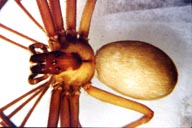 |
Figure 1
|
Figure 2
|
| Close-up of the cephalothorax of the brown recluse spider, Loxosceles reclusa, (from Missouri) showing the pattern of 6 eyes arranged in dyads |
A preserved brown recluse spider showing the strongly contrasting and well-defined violin pattern on the cephalothorax as well as the patternless abdomen covered with fine hairs. |
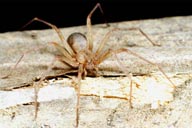 |
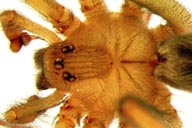 |
Figure 3
|
Figure 4
|
| A desert recluse, Loxosceles deserta, (from near Indio, Calif) showing the lack of a strongly defined violin pattern. |
The cephalothorax of a preserved desert recluse showing the characteristic recluse eye pattern and a uniformly colored cephalothorax |
Misidentification of spiders as brown recluses is not uncommon both in the lay and medical communities. Many of these mistaken spiders are similar in only one trait with actual recluse spiders, with some only sharing the characteristics of brown color and eight legs.
« Previous Page —
Next Page »

